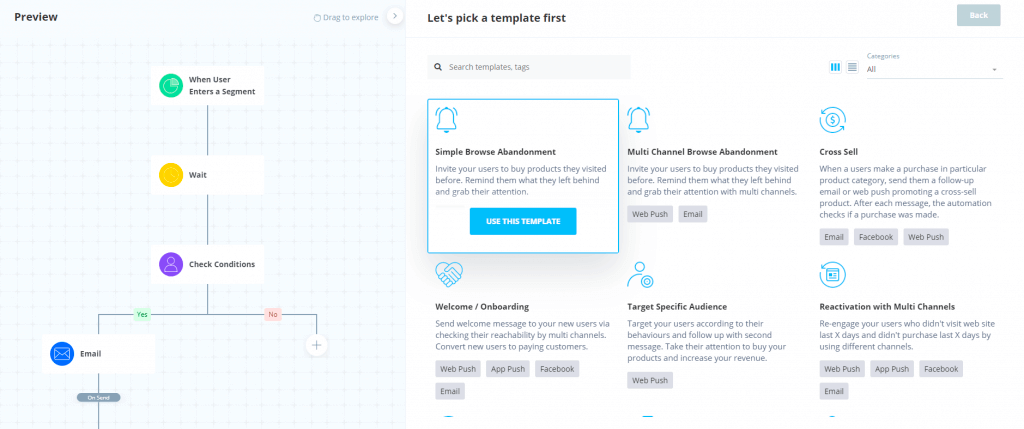Customer Journey Map
A customer journey map is defined by the Harvard Business Review as “a diagram that illustrates the steps your customer(s) go through in engaging with your company, whether it be a product, an online experience, retail experience, or a service, or any combination. The more touchpoints you have, the more complicated—but necessary—such a map becomes.”
The map outlines the multiple touchpoints a customer encounters throughout their engagement, from initial awareness to post-purchase support. By meticulously plotting each stage of the customer’s interaction, including points of engagement, emotions, challenges, and motivations, a journey map provides a holistic understanding of the customer’s perspective.
What is a customer journey map?
The customer journey map guides marketers through the stages, touchpoints, and emotions that define a customer’s interactions from the first point of contact to long-lasting loyalty. It’s a valuable insight, empowering businesses to identify pain points, optimize experiences, and tailor their offerings to align more closely with customer needs and behaviors. In essence, a well-crafted customer journey map serves as a blueprint for enhancing customer satisfaction, loyalty, and brand success.

How to create a customer journey map
- Define your goals
Start by establishing clear goals for your customer journey map. Are you aiming to enhance customer satisfaction, uncover pain points, optimize touchpoints, or something else? Defining your objectives provides a focused direction for the map’s creation, ensuring that it aligns with your desired outcomes.
- Understand your customers
Segment your customer base into distinct personas based on factors like demographics, behaviors, and preferences. By understanding the different types of customers you serve, you can tailor the journey map to accurately represent each group’s unique experiences and needs. Gather data through surveys, interviews, and analytics to gain deeper insights into their behaviors and expectations.
- Map the touchpoints
Identify the touchpoints where customers interact with your brand, both online and offline. These touchpoints encompass a range of interactions, from social media engagement and website visits to customer service calls and in-store experiences. Listing these touchpoints provides a comprehensive view of how customers engage with your brand throughout their journey.
- Plot each stage
Divide the customer journey into stages that represent the key phases customers go through when interacting with your brand. Common stages include awareness, consideration, purchase, and post-purchase. Each stage marks distinct customer actions, emotions, and expectations, helping you map out the evolution of the customer experience over time.
- Visualize the experiences
You can now transform your insights into a visual representation by creating the customer journey map. This map can be a flowchart, diagram, or other visual aid that illustrates the customer’s progression through the stages and touchpoints. By visually depicting emotions, actions, and pain points, you can better understand the highs and lows of the customer experience.
- Identify new opportunities
Within the journey map, identify pain points where customers encounter challenges or negative emotions, as well as opportunities where you can create positive interactions. Pinpointing these areas empowers you to develop strategies to alleviate pain points and enhance positive experiences, ultimately improving customer satisfaction and loyalty.
- Share and collaborate across teams
Engage cross-functional teams across your organization to collaborate on the journey map. This includes marketing, sales, customer service, and product development departments. Collaboration ensures that insights and strategies are aligned, fostering a holistic approach to enhancing the customer experience.
- Implement any changes
Use any insights found in steps six and seven to inform actionable strategies and capitalize on opportunities to create seamless and enjoyable interactions. Implementing these changes enhances the overall customer experience and strengthens your brand’s relationship with customers.
- Keep it current
Customer behaviors and market trends evolve over time. Make sure to regularly revisit and update your customer journey map to reflect these changes. Keeping the map current ensures that your strategies remain relevant and effective in meeting customer expectations and delivering a superior experience.
💡With a customer journey orchestrator tool like Insider, you can edit your customer journeys based on new discoveries in real-time. We even have templates to help guide you.

Why is customer journey mapping important?
Any marketer should build and use customer journey maps to understand their customers. From insights to decision-making, here are seven reasons you should get started:
- Deeper customer insight: Customer journey mapping reveals customer experiences, insights, and emotions, enabling businesses to understand their needs better.
- Effective pain point resolution: Businesses enhance satisfaction and reduce churn by identifying and addressing pain points.
- Consistent cross-channel experience: Mapping ensures consistent experiences across multiple touchpoints, promoting a seamless journey.
- Personalization and loyalty: Insights drive personalized interactions, increasing conversions and fostering long-term loyalty.
- Proactive problem-solving: Mapping anticipates challenges, enabling businesses to proactively meet customer needs.
- Informed decision-making: Data-driven insights guide resource allocation and strategic improvements.
- Measurable impact: Improvements are quantifiable through metrics, enabling businesses to track progress.
What are the benefits of customer journey mapping?
Customer journey mapping offers a range of benefits, revolutionizing how businesses approach customer experiences. By providing insights into behaviors, preferences, and pain points, it facilitates tailored interactions and a holistic understanding of the entire journey.
When using a cross-channel customer journey platform like Insider, this clarity can enable smoother touchpoints and higher satisfaction in real-time. Through data-driven decision-making, cross-functional collaboration, and personalized experiences, businesses can boost loyalty and retention and establish a competitive edge. Ultimately, customer journey mapping drives a customer-centric culture for marketing teams, empowers innovation, and builds lasting relationships founded on trust and excellence.













